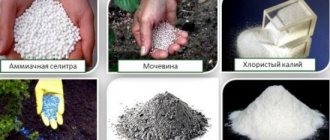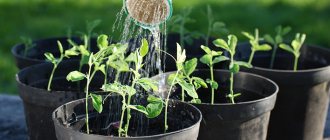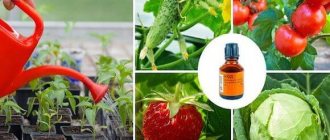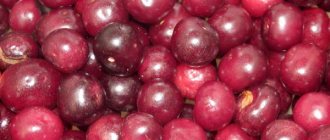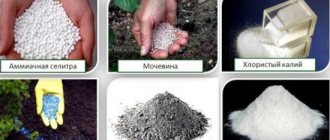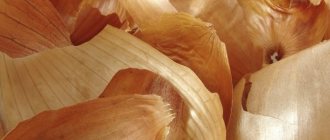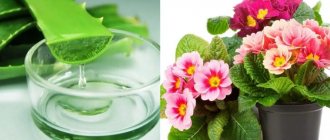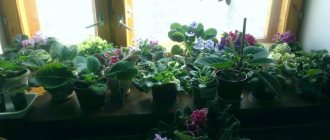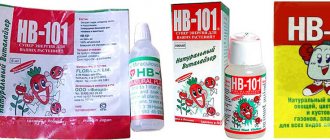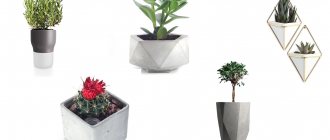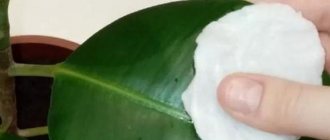Potted plants decorate any interior and create an atmosphere of comfort. In order for them to delight you with their rich greenery and flowering all year round, you must provide them with the necessary conditions of detention, as well as comprehensive care, including not only regular watering, spraying, timely replanting, but also the mandatory application of fertilizers. We will tell you in the article how to feed indoor flowers depending on their type, season, and type of fertilizer.
Well-groomed “green pets” delight with lush foliage, abundant long-lasting flowering, and some even with fruits
How to feed potted plants
Today, there is no shortage of fertilizers that nourish the soil and potted plants. In specialized flower departments and shops you can purchase:
- ready-made organic concentrates;
- organomineral mixtures;
- growth stimulants for seedlings and seeds;
- mineral fertilizers for any flowers;
- universal fertilizers, complex supplements with microelements and vitamins.
Fertilizers are selected according to the needs of a particular type of home flower. For example, flowering plants require a completely different set of nutrients than cacti or decorative foliage species.
Types of house plants:
- cacti and succulents;
- conifers;
- citrus fruits (kumquats, lemons, oranges);
- decorative deciduous;
- beautifully flowering.
Features of feeding domestic flowers and preferences for exotics:
- for flowers with abundant aerial parts or large leaves, nitrogen fertilizing is needed;
- for flowering plants, first of all, potassium and magnesium are needed;
- cacti and succulents, even in a complex diet, consume more phosphorus;
- It is not recommended to use organic additives for cacti, succulents, bulbous and tuberous plants, and gerberas;
- flowers of the Cycad family (Cycas, Cycads), on the contrary, absorb organic matter better; rotted horse or cow manure is diluted in water in a ratio of 1 tbsp. l. organic mixture per 1 liter of water;
- variegated flowers are fed carefully; from an excess of nutrients, the beautiful pattern is “washed off”, the leaf blade becomes completely green.
General rules
Flower growers recommend adhering to the general rules for applying fertilizers for ornamental plants:
- after transplantation, flowers are not fed for at least 1.5-2 months;
- it is important to follow the diet - any fertilizer is applied once every 2-3 weeks;
- in autumn, nutrition is reduced to a minimum for most plants preparing for hibernation;
- in winter , as a rule, mineral and organic fertilizers are not required for plants, additional nutrition causes activation of growth processes, and the natural development cycle is disrupted;
- you should not skip starting spring feedings , starting from the end of February; the flowers have rested over the winter, new strength and additional nutrition are needed for growth and development, the formation of buds;
- summer fertilizing is applied to maintain nutritional balance, long flowering, resistance to heat and lack of air humidity;
- any drug is added in a precise dosage , preparation of solutions “by eye”, experimental combinations of tank mixtures are strictly prohibited; an excess of elements is fraught with irreversible consequences;
- a sick or infected plant is immediately sent to quarantine , rapid infection of all flowers is possible;
- for sick specimens affected by insects or infections, priority is given to medical and health procedures (sanitary pruning, replanting, substrate replacement, treatment with fungicides, insecticides); Fertilize only healthy plants;
- nutrient solutions are added to the moist substrate evenly along the edge of the container; after watering or showering, the plant should be dried in a shaded place; Spraying is carried out in the early morning or after sunset.
When can you not stimulate?
In some cases, feeding the plant with preparations for lush and abundant flowering is not recommended:
- Do not apply fertilizer if the plant is sick or infested with pests.
- Plants are not fed during the dormant period (for most crops this period lasts from November to March). The exception is plants that re-bloom in winter.
Before using any drug that stimulates flowering, you must carefully read the instructions. Each crop needs a certain amount of feeding. Plants respond to introduced stimulating substances within a strictly limited period.
Types of fertilizers for indoor flowers
Agrochemical companies produce fertilizers in various forms:
- liquid mineral supplements in the form of nutritional concentrates;
- mineral fertilizers in powder form and granules - water-soluble preparations;
- nutritional sticks and sustained release tablets;
- special mineral complexes for a certain type of indoor flowers.
Organic
Organic fertilizers (compost, manure) are used for ornamental vegetation in open ground . In indoor floriculture, mineral mixtures and additives are often used. Organic matter is harder to digest and takes longer to digest; it is difficult to calculate the exact dosage and percentage of macro- and microelements.
Available organic fertilizers for indoor plants and house flowers:
- cow or horse manure;
- wood ash (with a lack of magnesium);
- bird droppings;
- compost;
- herbal infusions and fermenters;
- yeast mixtures;
- horn shavings (flour), blood meal (organic nitrogen fertilizer based on meat production waste);
- ready-made organic concentrates in granules (Chicken chicken, Chicken manure, Biome).
Mineral
Experienced summer residents use traditional mineral fertilizers as root fertilizers and soil fillers when planting or replanting. In this case, it is important to consider the type of plant, its seasonal needs, the age of the flower, and the volume of the pot or container.
Prepare mineral nutrient solutions yourself for starting spring feeding:
- 2 tsp. ammonium nitrate;
- 0.5 tsp. potassium salt 40%;
- 1 tsp. superphosphate;
- dissolve the ingredients in 10 liters of water;
- for a 1 liter capacity, the consumption rate is no more than 70 ml;
- Fertilizer is applied to the spilled soil.
Nitrogen fertilizers for home flowers:
- ammonium, potassium or calcium nitrate;
- ammonium sulfate;
- urea (urea).
Phosphorus fertilizers for indoor plants:
- phosphate rock;
- monopotassium phosphate;
- superphosphate.
Potassium supplements:
- potassium salt, 40%;
- potassium sulfate (potassium sulfate).
Microelements for feeding home flowers:
- iron chelate;
- calcium nitrate (calcium nitrate);
- sulfates of magnesium, manganese, zinc, iron, copper;
- dolomite flour;
- boric acid.
Complex
It is more convenient and expedient to purchase complex specialized fertilizers with an individually selected composition of nutrients:
- “Complex organomineral fertilizer for decorative foliage flowers” , Bio Master, 0.35 l, containing a basic NPK complex, humates, microelements. Ideal for flowers with voluminous decorative (cut, spotted, striped) leaves - Dieffenbachia, Coleus, plants of the Palm family.
- "Organic cocktail ACTIV (Active)" , 500 ml. The series includes a universal preparation for all indoor flowers, for cacti, for violets, for flowering orchids, for palms and ficuses. Contains nitrogen, phosphorus, potassium, humic substances. A complex of microelements (boron, zinc, magnesium, molybdenum), according to the individual preferences of each group of plants. The working solution (5 ml per 0.5 l of water) is used for watering and spraying.
- Line of complex preparations from the company Bio Master (Bio Master) “Active organics” , 0.5 l. The assortment is large, the series includes universal flower fertilizer for violets, succulents, etc. Used to prevent leaf spot and chlorosis.
Organic
Granulated wood ash "Vitaflor"
Ash is a valuable remedy, a natural source of magnesium, sodium, calcium, phosphorus, and potassium. Strengthens productivity, immunity, protects any crops from diseases, and brings weakened plants back to life. Flowers take root better, produce large buds, and delight with intense color and aroma for a long time. It is important to consider the type of soil and variety; for example, violets require a minimum of ash. The modern form of release in granules does not generate dust, does not wash out, releases nutrients gradually and over a long period of time, and does not dramatically change the characteristics of the soil. Weight 1 kg. How much does it cost: plastic liter bucket - 140 rubles.
Advantages:
- Natural material for feeding;
- Ease of use;
- Gradual saturation;
- Strengthening the immune system.
Flaws:
- Not detected.
Organic dry fertilizer “Chicken manure” Fasco
Russian-made Fasco products receive numerous positive reviews. Chicken manure is a classic for increasing yields and flowering, as well as providing soil restoration. The manufacturer dried the natural material and granulated it while preserving the nutrients. This form guarantees environmental safety, does not contain pathogenic microflora, does not have a strong odor, and does not change characteristics during long-term storage. Packaging in bags from 0.8 to 3.5 kg.
Advantages:
- Harmless natural composition;
- No smell;
- Improvement of all types of soils;
- Improving the decorative qualities of the plant;
- Prolonged action;
- Ease of use and storage.
Flaws:
- Not detected.
Concentrated horse manure "Soft power"
A time-tested product for caring for plants. Contains elements that stimulate the vegetative process, necessary for optimal flowering. The manufacturer uses the fermentation method at a temperature of 43-56 degrees. The resulting concentrate is used in various ways, step-by-step instructions on the packaging. After vigorous shaking, dilute with water. The ratio for flowers is 1 to 20. Then you can soak the seeds, spray, water. In open ground or indoors. More often in summer, less often in winter.
Advantages:
- Natural, environmentally friendly;
- Economical consumption;
- All-season;
- Variety of applications.
Flaws:
- Not detected.
Pine bark UltraEffect Deco
Gardeners actively use pine bark chips in their summer cottages to protect flowers from frost or drought. In addition, the flowerbed looks well-groomed and decorative. For indoor flowers, the bark is used to create a substrate. Roses and orchids respond more gratefully than others. Mulch decomposes over time, leaving no harmful waste. Serves for several years. Contains fungicides that protect against insects. Varies in particle sizes. A 1.2 liter bag with pieces from 10 to 30 mm costs 120 rubles. Size 35-70 mm – 180 rubles.
Advantages:
- Without harmful substances;
- Prolonged effect;
- With decoration function.
Flaws:
- Expensive on large areas.
Feeding indoor plants with folk remedies at home
With your own hands, you can prepare nutrient mixtures and solutions for spraying from simple pharmaceutical preparations, food waste, and yeast. Let's consider several options for folk remedies for home flowers and plants.
Yeast
Yeast is an indispensable tool for phytostimulation and feeding of domestic vegetation.
Important: 100 g of dry compressed yeast contains 12 g of protein; protein is a source of nitrogen compounds.
Benefits of baker's yeast for indoor flowers:
- maintaining the physiological and aesthetic state of ornamental plants by stimulating photosynthesis and respiration;
- yeast, getting into the soil, continues to function, has a beneficial effect on the growth and development of the root system, and blocks the vital activity of pathogenic microorganisms;
- the active elements of yeast synthesize biologically active substances in the process of vital activity;
- The fungal base of yeast contains a huge amount of protein (protein), mineral elements and amino acids.
Plant growth and development stimulants
Immunostimulant biological products and phytohormones are used to protect and support indoor plants during planting and replanting, and soaking planting material.
Modern drugs have proven themselves well:
- HB-101 , Japanese biostimulator-vitalizer, immunomodulator, 50 ml (liquid) and granular form. Natural nutritional concentrate (extract from cedar, plantain, pine, beet) is compatible with any mineral and organic solutions. Feature - economical consumption - only 5-7 granules are required for a pot with a volume of 1-1.5 liters. The method of application is simple - the granules are evenly laid out around the perimeter and buried 1 cm into the surface wet layer of soil. The fertilizer is enough for a whole year.
- Radifarm (Radіpharm) , 25 g – rooting agent, biostimulator, liquid fertilizer. Contains microelements, chelates, vitamins. Suitable for all blooming and indoor flowers. Used when planting (soaking cuttings), transplanting adult specimens.
- Epin Extra , 1 ml – steroidal phytohormone, immunomodulator and growth stimulator. Used for decorative garden crops and house flowers. Ensures good survival of plants, blocks the development of pathogenic microflora (natural antibiotic). Quickly absorbed, digested within 2 weeks.
- Zircon , 1 ml – natural growth regulator. The active basis of the drug is echinacea extract. Feature – provides protection for indoor flowers from summer heat and overheating.
How to understand that a flower needs fertilizer?
The appearance of indoor flowers is an indicator of health and normal vegetative development. An excess or lack of light, moisture, and nutrients directly affects the quantity and quality of green above-ground mass, leaf size, bud formation, ovary, annual growth, and flowering.
External signs
The lack of minerals in the soil is determined by external signs:
- the flower has stopped developing, does not grow, the leaf blade becomes smaller, dries, withered foliage is light in color - there are few nitrogen compounds ;
- the edges of the leaves turn yellow, the leaves fall out of season, young shoots are stunted in growth, the stems become thinner; dried leaves have a dark (black) color - phosphorus deficiency ;
- from a lack of potassium and zinc , the leaves turn yellow, punctures appear on the plate; with potassium deficiency , the leaves become dull, a bluish or bronze tint appears, the edges of the leaves turn brown; brown spotting is possible, the edges curl, the leaf blade becomes wrinkled;
- with calcium deficiency , young leaves become bent, the edges curl upward, a brown border appears along the very edge, the apical buds and root shoots die off, and the root begins to branch heavily;
- a lack of magnesium provokes chlorosis of the leaves, the edge and interveinal space of the leaf plate turns yellow or red, the tissues gradually die, the veins remain green, the edges and tips bend and wrinkle; First, the lower leaves are affected, then the upper ones;
- with boron deficiency , the growth point is affected, root shoots suffer, buds die, the stem becomes bent, side stems grow profusely, leaves turn pale and curl; flowering is delayed or stops (buds and flowers fall off);
- from a lack of copper, young leaves lose turgor, droop, then fall off, the edges turn white (chlorosis), the plate becomes deformed, the flower bushes and stops growing;
- iron deficiency causes leaf chlorosis; the upper leaves turn pale or yellow, the tissue between the veins turns white, gradually whitish stripes appear over the entire surface of the leaf;
- a deficiency of manganese appears on young leaves, interveinal chlorosis first affects the base of the leaf blade, the surface of the leaf gradually turns yellowish-gray, while the veins remain green, visually the leaf becomes variegated; chlorotic tissues die, spots of various sizes and colors appear.
Causes
In nature, each plant adapts to its natural living conditions, climate, and is a participant in the cycle of substances in nature. Soil bacteria, earthworms, and insects process the soil and nutrients become available. The plant world receives mineral fertilizers in full naturally.
At home, potted crops are excluded from the cycle, and natural soil processes cease over time. Flowers absorb only those elements that are introduced artificially.
In addition, if the plant lives in a pot or tub, the amount of soil for it is naturally limited.
A year after planting, even the most well-filled and nutritious soil is depleted, and the flowers begin to “starve.” Ignoring seasonal mandatory fertilizing and individual preferences of indoor flowers leads to a weakening of phytoimmunity; plants are affected by infections and viruses.
Florists note that it is in autumn that indoor plants suffer from stress , temperature and air humidity change, and daylight hours are reduced. The leaves turn yellow, become covered with spots, and harmful insects seek shelter for the winter. Lack of attention and improper care leads to the death of the flower.
In what cases will they help?
Plants themselves notify gardeners about a lack of nutritional components. The owner’s task is to timely diagnose warning signs and eliminate them. The needs of the flora are concentrated around three elements: nitrogen, phosphorus and potassium. The disadvantage of each of them has its own characteristic features.
Nitrogen
Nitrogen has the status of the main nutrient element for all representatives of the flora. The plant absorbs this component when its stems and leaves develop.
If access to the element at the roots is reduced, the grower observes the following manifestations:
- leaves turn pale due to low chlorophyll content;
- Tillering and flowering weaken;
- the stem becomes thinner and may break if handled carelessly;
- the ovaries fall off prematurely;
- seeds and fruits will not have time to develop.
Important. Excess nitrogen leads to the growth of the green part of the plant to the detriment of the fruit. Prolonged lack of the element leads to yellowing of the leaves.
Phosphorus
Phosphorus controls energy processes that take place at the cellular level. It helps plants ripen and bloom in a timely manner. Another useful function of the element is considered to increase the resistance of flora to diseases.
Phosphorus deficiency can be recognized by the following symptoms:
- the lower leaves take on an unnatural dark green hue;
- leaves become covered with brown or red-violet spots;
- shoots stop growing;
- new leaves grow small, and the buds do not open.
Important. Plants overfed with phosphorus cease to accept iron and zinc.
Phosphorus-potassium
Potassium phosphorus helps plants properly absorb water and normalizes metabolism. It plays an important role during the period of active growth, as it increases the plant’s resistance to the vagaries of the weather. Without phosphorus-potassium supplements, the flora cannot develop a root system that will remain resistant to fungi and other pests.
Plants are notified of a lack of phosphorus-potassium group fertilizers as follows:
- change in leaf shape;
- drying of leaves (starts at the edges); healthy and shrunken zones are separated by a brown stripe;
- in citrus and nightshade plants, the internodes are shortened, and the leaves become wrinkled and curl upward;
- leaves become covered with necrotic brown spots and fall off due to an acute lack of phosphorus and potassium;
- the buds open later than expected.
Important. Excess potassium is indicated by pale or discolored foliage.
Advice from experienced flower growers
Attention! Homemade folk remedies do not completely replace mineral supplements. Homemade organic mixtures are used as a nutrient supplement, but not as a main base fertilizer.
Some simple tips from florists:
- soft water is needed for irrigation or nutrient solution . A simple and convenient way to soften water is to lower a fabric bag of peat (100 g) into a 2-3 liter watering can. After a day, the water will become soft. The peat cleaner is used 2-3 times, and then the peat is renewed.
- After introducing phytostimulants and watering, the top layer of soil is covered with food foil . The shelter will reduce evaporation and serve as additional lighting (the foil reflects the sun's rays). The method is convenient if in the summer the owners go to the dacha and home flowers are left for a short time without care.
- It is important to remember that house plants get sick and suffer from insects . To prevent possible troubles, regular inspection and special preventive and eradicating treatments with fungicides and insecticides are needed.
